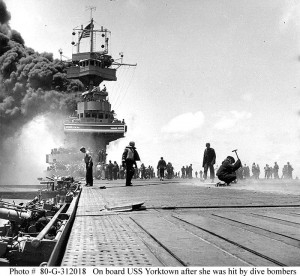The Significance of Airpower
Author: Jim Zabek
Airpower in warfare has been employed for over a century. Examples of its use go back as far as the American Civil War, where hot air balloons were used for aerial reconnaissance. The First World War saw an expansion of role of aircraft, and the typical roles that aircraft play in combat were largely defined during that conflict. Fighters, bombers, interceptors, and reconnaissance aircraft all emerged during World War One. But it was during the Second World War that airpower evolved from being a part of combined arms operations to being a fully-fledged combat arm of its own, capable of tipping the scales of battle on its own.

To be sure, infantry was then and remains now the Queen of Battle. Boots on the ground are what ultimately take and hold territory. But World War Two was the first time that airpower decisively and singularly tipped the tide of battle.
In Walter J. Boyne’s book Clash of Wings (later made into a historical mini-series for TV) Boyne claims that there were four significant battles during the Second World War.
“There were four great battles in World War II upon which the tide of history turned – the battles of Britain, Midway, El Alamein, and Stalingrad. Of these, two were truly revolutions in warfare, while two were classic examples of matériel-driven land battles.”
To be certain those four battles were not isolated events. Manufacturing ability, logistics, and manpower combined with clear strategies and objectives over the course of many years ultimately won the war. But the Battle of Britain, Midway, El Alamein, and Stalingrad were the major turning points of the war. Had they not taken place surely some other, similar battles would have filled the gap. But it was these four battles where the overall turning points of the war were seen.
If we accept those four battles as the turning points one obvious thing stands out: two were conducted solely by aircraft. To expand on that line of reasoning, the next logical step is to conclude that airpower, and airpower alone, determined one half of the significant battles of the Second World War.
Grogs, of course, will have no trouble recalling those four battles, but gamers less familiar with military history may want a quick refresher. The Battle of Britain was fought between the Royal Air Force (RAF) and the Luftwaffe. A very close run thing, Britain’s victory over the Germans ensured that there could be no successful invasion of the islands. Midway, fought between the Imperial Japanese Navy (IJN) and the United States Navy (USN) sank or damaged most of Japan’s aircraft carriers and ensured that the Japanese would remain on the defensive for the rest of the war. The US could then prioritize its efforts to win the war in Europe, before turning its full attention back to the Pacific. El Alamein saw the British Army overcome the Wehrmacht, driving Germany from North Africa, and opening the route to an ultimately successful invasion of Italy and Southern Europe, with the final goal being the successful removal of Italy from the war. Stalingrad saw the USSR’s Army engulf, besiege, and utterly destroy the Wehrmacht’s Sixth Army, putting the Germans on the Eastern Front in a strategically defensive posture for the rest of the war. Had the Allies failed at any of those battles the Axis might have had a high probability of winning the war. (Don’t agree? Debate about it in our forums!)
Winston Churchill famously remarked on the Battle of Britain that, “Never in the field of human conflict was so much owed by so many to so few.” Those words could equally have been said of Midway. Both El Alamein and Stalingrad saw huge investments (and loses thereof) in manpower and equipment. Conversely, The Battle of Britain started with the Luftwaffe fielding 2500 aircraft of all types versus the RAF’s 700 fighters. Midway was settled by even fewer planes; the USN sent three aircraft carriers, Enterprise, Yorktown, and Hornet plus assorted escort ships settled by a few hundred planes and pilots. The Japanese had dispatched Kaga, Akagi, Soryu, and Hiryu and between those four carriers they had about 250 planes. The three American carriers fared slightly better. The Yorktown could carry 96 aircraft, Enterprise and Hornet could carry 90 aircraft each. In addition Midway Island had another 104 aircraft available to it. It’s difficult to believe that a battle that shifted the balance of power in the Pacific was determined by fewer than 650 planes, but that is exactly what happened.
The age of airpower had arrived. Four more hard years and millions of lives would be lost before the war would be over, but the 600 planes at Midway and the 3200 over Britain determined much of the fate of the war. Sharp and decisive, Midway was over in a matter of days. The Battle of Britain lingered and went through several phases but lasted no longer than a few months. For such significance it seems difficult to believe that so much of the war was determined by so few, but there it is.
Modern aircraft can seem almost obscenely expensive. Cost overruns, scope creep, and changes from the original design can cause a modestly expensive military aircraft to become much more expensive. No one can argue that efficiencies in military procurement aren’t necessary, but at the end of the day, the next time someone questions whether the military needs to improve the quality or quantity of its aircraft, remember back to the battles of Midway and Britain. Let us hope that never again will so much be owed by so many to so few.
Additional Recommendations








“The first decisive use of a balloon for aerial observation was performed by the French Aerostatic Corps using the aerostat l’Entreprenant (“The enterprising one”) at the Battle of Fleurus in 1794.”
Wikipedia, ‘History of military ballooning’ article